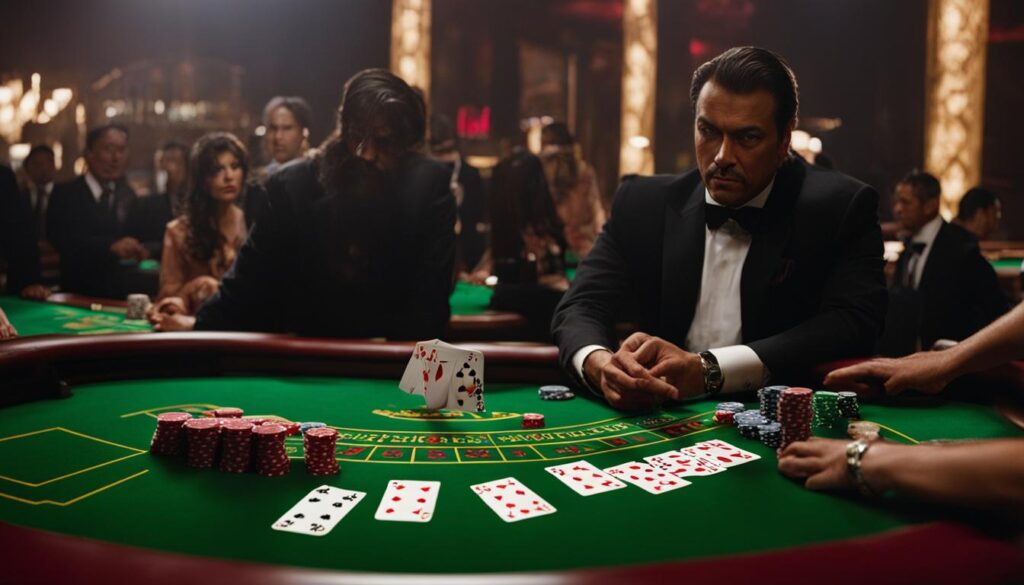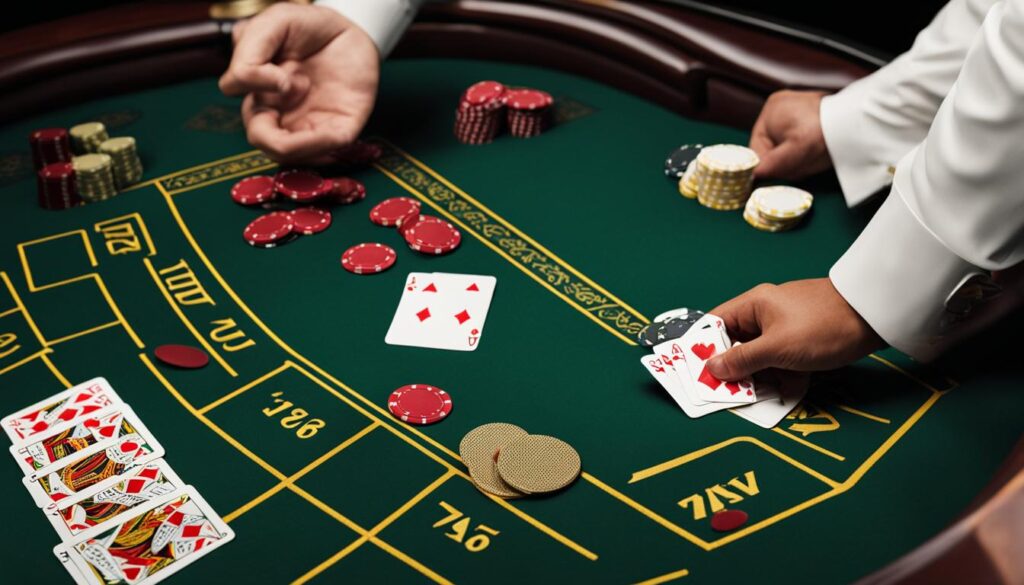Blackjack is a popular card game that is played in casinos around the world. It is a game of skill, strategy, and luck, and there are many different variations of the game. One of the most important aspects of playing blackjack is understanding the rules that determine when a dealer must hit.
In this section, we will discuss the blackjack rules that govern when a dealer must hit and how understanding these rules can help you develop a winning strategy. We will also explore the basic gameplay and conditions that determine when a dealer must hit or stand.
Key Takeaways
- Understanding the dealer hitting rules is essential for winning at blackjack.
- The dealer must hit if their hand is worth less than 17.
- Players can use the dealer’s hitting rules to make informed decisions about their own gameplay.
- Knowing the dealer hitting rules is the first step in developing a successful blackjack strategy.
- Specific rules for dealer hitting can vary in different variations of blackjack.
The Basics of Blackjack Dealer Rules
When playing blackjack, it’s important to understand the basic rules that govern how the dealer will play their hand. The dealer’s actions are determined by a set of predetermined rules that dictate when they must hit and when they must stand. These rules may vary slightly depending on the specific variant of the game, but the basic principles remain the same.
First and foremost, the dealer must always follow the established blackjack dealer rules. Generally speaking, the dealer must hit when their hand is worth less than 17 and stand when their hand is worth 17 or more. However, some variants of blackjack may require the dealer to hit on a “soft” 17 (a hand that includes an Ace that can be worth 1 or 11 points), while others may allow the dealer to stand on a 16.
The dealer’s actions are also governed by the value of the player’s hand. If the player’s hand exceeds 21, the dealer automatically wins and there is no need for them to draw any additional cards. However, if the player’s hand is worth less than 21, the dealer must continue to hit until their hand is worth 17 or more. At that point, they must stand and the winner of the game is determined based on who has the highest hand value.
It’s important to keep these rules in mind when developing a blackjack strategy. By understanding when the dealer must hit and when they must stand, players can make more informed decisions about when to hit, stand, or double down. This knowledge can help players maximize their chances of winning at the blackjack table.

Summary
The basic rules of blackjack dealer play are straightforward: the dealer must hit on their hand until it is worth 17 or more, and they must stand if their hand is worth 17 or more. The specific rules may vary depending on the variant of blackjack being played, but these principles remain the same. By understanding these rules, players can develop a more effective blackjack strategy and improve their chances of winning.
When Does a Dealer Hit in Blackjack?
In blackjack, the dealer’s actions are determined by a set of rules that dictate when they must hit and when they must stand. If the dealer’s hand value is less than 17, they must hit. If their hand value is 17 or higher, they must stand. However, there are a few exceptions to this rule that may vary depending on the particular variation of blackjack you are playing.
For example, some variations of blackjack may allow the dealer to hit on a soft 17 (a hand that includes an Ace that can be counted as either 1 or 11). In these cases, the dealer would be required to hit even if their hand value is technically 17. Conversely, some variations of blackjack may require the dealer to stand on a soft 17.
Understanding when a dealer must hit in blackjack is crucial for developing a winning strategy. By recognizing the specific conditions that trigger a hit, players can make more informed decisions about when to hit or stand themselves, giving them the best chance of winning the hand.

Example:
| Dealer’s Hand | Player’s Hand | Action |
|---|---|---|
| 13 | 16 | Hit |
| 17 | 18 | Stand |
| Ace, 6 | 19 | Stand |
In the example above, the dealer has a hand value of 13, which means they are required to hit according to standard blackjack rules. The player has a hand value of 16, which is lower than the dealer’s hand value, so they would also be advised to hit in this situation.
Understanding the Dealer Hitting Rules.
When playing blackjack, it’s essential to understand the dealer hitting rules. This knowledge can help you make informed decisions and increase your chances of winning at the table. Generally, dealers must hit on any hand worth less than 17 points and stand on any hand worth 17 or more points.
However, there are some exceptions to this rule, depending on the particular variation of blackjack being played. For example, in Double Exposure Blackjack, the dealer’s cards are both dealt face up, which gives players an advantage. To level the playing field, the dealer wins all ties except for blackjack. Additionally, some variations allow the dealer to stand on a soft 17 (a hand that contains an Ace and counts as 11 points).
Knowing when a dealer must hit can help you make strategic decisions about your own hand. For example, if the dealer is showing a 6, a common strategy is to stand on any hand worth 12 or more points, as the dealer is likely to bust (i.e., go over 21) and you don’t want to risk going bust yourself.
“In blackjack, the dealer has a fixed set of rules that they must follow. This gives players an advantage, as they can make strategic decisions based on the dealer’s hand and increase their chances of winning.”
To summarize, understanding the dealer hitting rules is a key component of developing a successful blackjack strategy. By knowing when the dealer must hit or stand, you can make informed decisions about your own hand and maximize your chances of winning at the table.
Developing a Blackjack Strategy Based on Dealer Rules
Understanding the rules that govern when a dealer must hit in blackjack is crucial for players who want to develop a winning blackjack strategy. By knowing these rules, players can make informed decisions and maximize their chances of success at the blackjack table.
One important thing to keep in mind is that the dealer must continue to hit until they have a hand valued at 17 or higher, and must stand (stop hitting) if their hand is valued at 17 or higher. This rule is consistent across all variations of blackjack. However, there may be other specific rules that vary in certain games, such as whether the dealer must hit on a soft 17.
One effective strategy for players is to pay attention to the dealer’s upcard (the card face up on the table) and adjust their own play accordingly. For example, if the dealer’s upcard is a 6, players may be less likely to hit if their own hand is valued at 12 or higher, knowing that there is a good chance the dealer will bust (exceed a hand value of 21) with the next hit.
Another key strategy is to memorize basic strategy charts, which show the optimal plays to make in every possible scenario based on the player’s hand and the dealer’s upcard. These charts take into account the dealer hitting rules and can significantly improve a player’s overall success rate.
In conclusion, understanding the rules governing when a dealer must hit in blackjack is essential for any player looking to develop a successful strategy. By focusing on the dealer’s upcard and memorizing basic strategy charts, players can maximize their odds of winning and achieve greater success at the blackjack table.
Conclusion
Understanding the dealer hitting rules is a crucial aspect of mastering the game of blackjack. By knowing when the dealer must hit and when they must stand, players can make informed decisions that maximize their chances of success at the table.
Developing a solid blackjack strategy requires a deep understanding of these rules, as well as an awareness of how they impact the game. By following the tips and strategies outlined in this article, players can improve their gameplay and increase their chances of winning big.
Remember, the key to winning at blackjack is to be patient, persistent, and always remain focused on the game at hand. With the right strategy, a bit of luck, and a deep knowledge of the dealer hitting rules, anyone can become a successful blackjack player.